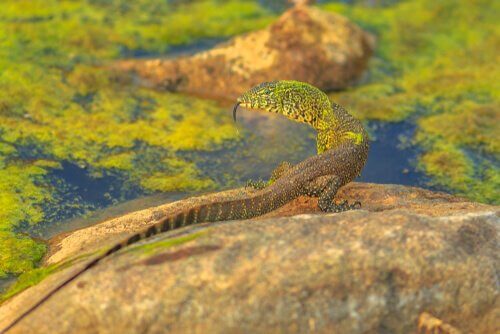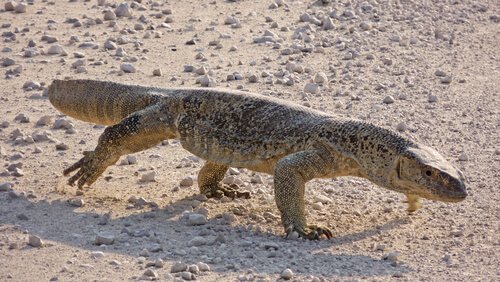What are Monitor Lizards?


Written and verified by the vet Eugenio Fernández Suárez
Monitor lizards, or Varanus lizards, are a very little known group of large animals that have great intelligence.
What are monitor lizards?
These animals are reptiles native to Oceania, Asia, and Africa that have become invasive exotic species in some countries in the Americas. They have existed at least since the Miocene period, and eighty species still exist today.
Monitor lizards are corpulent animals that have strong necks that allow them to tear off flesh. They have very strong claws and tails, especially the Komodo Dragon. This is a three-meter monitor lizard and they’re considered to be largest one; especially in comparison to the Australian dwarf monitor lizards, which are only 20 centimeters long.
However, there were larger monitor lizards than the Komodo dragon. The megalania, which is known as the great wanderer, was a giant monitor that inhabited Australia 30,000 years ago. It’s believed that they could have coexisted with Aboriginal human populations.

Diet
Most monitor lizards are terrestrial and carnivorous animals. However, there are also some arboreal or semi-aquatic monitor lizards. There’s even some that eat fruit and vegetables.
Monitor lizards can eat insects, crustaceans, mollusks, fish, amphibians and even birds, other reptiles and mammals. Some of them, like the Komodo dragon, can prey on large deer.
As is the case with snakes, monitor lizards have a highly developed vomeronasal organ and locate their prey through their sense of smell. As with ophidians, they have a forked tongue. This is unlike other quadrupedal reptiles, like crocodiles and iguanas.
These animals can eat prey that’s much larger than their own size. Like snakes, they have an adaptation in their upper jaw that’s separate from the rest of the skull.
Behavior
Monitor lizards are traditionally solitary animals. However, in areas with limited resources, you can find them in groups of up to fifty lizards. This is because they’re active hunters in large territories.
These large reptiles are an interesting group of animals. Although they’re very anatomically similar, there are large differences between the sizes of the members of the group. They’re much more active than other reptiles, so they have a higher metabolic capacity.
Unlike most reptiles, the monitor’s heart is very similar to that of mammals. It has a ventricular septum, which separates the two chambers as the heart beats. This allows oxygen to travel much more efficiently.

When talking about monitor lizards, people often wonder if they’re venomous. Their bite will draw blood and is fairly painful. However, it hasn’t been proven if this is due to venom or to infections caused by oral bacteria.
Threats to monitor lizards
These reptiles are one of the most threatened groups of animals. Spain is considered as the gateway for illegal trafficking of animals in Europe. Especially in the case of reptiles, and more specifically monitor lizards.
These animals are used as pets, which has made Spain one of the key countries in the fight against illegal reptile trafficking. Hopefully, the last dragons on Earth won’t disappear.
Monitor lizards, or Varanus lizards, are a very little known group of large animals that have great intelligence.
What are monitor lizards?
These animals are reptiles native to Oceania, Asia, and Africa that have become invasive exotic species in some countries in the Americas. They have existed at least since the Miocene period, and eighty species still exist today.
Monitor lizards are corpulent animals that have strong necks that allow them to tear off flesh. They have very strong claws and tails, especially the Komodo Dragon. This is a three-meter monitor lizard and they’re considered to be largest one; especially in comparison to the Australian dwarf monitor lizards, which are only 20 centimeters long.
However, there were larger monitor lizards than the Komodo dragon. The megalania, which is known as the great wanderer, was a giant monitor that inhabited Australia 30,000 years ago. It’s believed that they could have coexisted with Aboriginal human populations.

Diet
Most monitor lizards are terrestrial and carnivorous animals. However, there are also some arboreal or semi-aquatic monitor lizards. There’s even some that eat fruit and vegetables.
Monitor lizards can eat insects, crustaceans, mollusks, fish, amphibians and even birds, other reptiles and mammals. Some of them, like the Komodo dragon, can prey on large deer.
As is the case with snakes, monitor lizards have a highly developed vomeronasal organ and locate their prey through their sense of smell. As with ophidians, they have a forked tongue. This is unlike other quadrupedal reptiles, like crocodiles and iguanas.
These animals can eat prey that’s much larger than their own size. Like snakes, they have an adaptation in their upper jaw that’s separate from the rest of the skull.
Behavior
Monitor lizards are traditionally solitary animals. However, in areas with limited resources, you can find them in groups of up to fifty lizards. This is because they’re active hunters in large territories.
These large reptiles are an interesting group of animals. Although they’re very anatomically similar, there are large differences between the sizes of the members of the group. They’re much more active than other reptiles, so they have a higher metabolic capacity.
Unlike most reptiles, the monitor’s heart is very similar to that of mammals. It has a ventricular septum, which separates the two chambers as the heart beats. This allows oxygen to travel much more efficiently.

When talking about monitor lizards, people often wonder if they’re venomous. Their bite will draw blood and is fairly painful. However, it hasn’t been proven if this is due to venom or to infections caused by oral bacteria.
Threats to monitor lizards
These reptiles are one of the most threatened groups of animals. Spain is considered as the gateway for illegal trafficking of animals in Europe. Especially in the case of reptiles, and more specifically monitor lizards.
These animals are used as pets, which has made Spain one of the key countries in the fight against illegal reptile trafficking. Hopefully, the last dragons on Earth won’t disappear.
All cited sources were thoroughly reviewed by our team to ensure their quality, reliability, currency, and validity. The bibliography of this article was considered reliable and of academic or scientific accuracy.
McNab, B. K., & Auffenberg, W. (1976). The effect of large body size on the temperature regulation of the Komodo dragon, Varanus komodoensis. Comparative Biochemistry and Physiology Part A: Physiology, 55(4), 345-350.
This text is provided for informational purposes only and does not replace consultation with a professional. If in doubt, consult your specialist.







